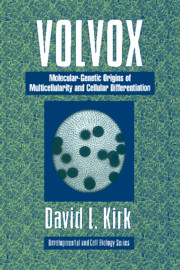 Volvox
Volvox Book contents
- Frontmatter
- Contents
- Preface
- Prologue
- 1 Introduction
- 2 The Volvocales: Many Multicellular Innovations
- 3 Ecological Factors Fostering the Evolution of Volvox
- 4 Cytological Features Fostering the Evolution of Volvox
- 5 Volvox carteri: A Rosetta Stone for Deciphering the Origins of Cytodifferentiation
- 6 Mutational Analysis of the V. carteri Developmental Program
- 7 Molecular Analysis of V. carteri Genes and Development
- Epilogue
- References
- Index
Epilogue
Published online by Cambridge University Press: 16 December 2009
- Frontmatter
- Contents
- Preface
- Prologue
- 1 Introduction
- 2 The Volvocales: Many Multicellular Innovations
- 3 Ecological Factors Fostering the Evolution of Volvox
- 4 Cytological Features Fostering the Evolution of Volvox
- 5 Volvox carteri: A Rosetta Stone for Deciphering the Origins of Cytodifferentiation
- 6 Mutational Analysis of the V. carteri Developmental Program
- 7 Molecular Analysis of V. carteri Genes and Development
- Epilogue
- References
- Index
Summary
The present contains nothing more than the past, and what is found in the effect was already in the cause.
Bergson (1911)The ultimate challenge for future Volvox research is to visit the past and retrace the pathway that led to the present.
Those of us currently engaged in Volvox research are excited by the challenge of capitalizing on the technical advances described in Chapter 7 to elucidate the detailed mechanisms by which cellular differentiation is programmed and executed in modern V. carteri. But when this goal has been achieved, the most distinctive attributes of Volvox as a developmental-genetic model system will still remain to be exploited. Although Volvox does offer a superb opportunity for defining the genetic and molecular basis of a highly interesting form of dichotomous cellular differentiation, it is not this feature that most clearly distinguishes Volvox from slime molds, fruit flies, plants, nematodes, zebrafish, mice, and other model organisms currently under intensive developmental-genetic investigation. Rather, it is the potential that it offers for tracing out in some detail the pathway by which such a program for cellular differentiation evolved.
As discussed in Chapter 1, multicellular organisms with a capacity for cellular differentiation clearly have evolved from simple unicellular ancestors numerous times; hence molecular mechanisms leading to dichotomous differentiation must have been independently invented many times in the past.
But in every other group that has been examined thus far, such inventions are buried so deep in antiquity that details of the pathway leading from unicellularity to multicellularity almost certainly have long since been obliterated by tectonic forces and the shifting sands of genetic drift.
- Type
- Chapter
- Information
- VolvoxA Search for the Molecular and Genetic Origins of Multicellularity and Cellular Differentiation, pp. 324 - 330Publisher: Cambridge University PressPrint publication year: 1997


